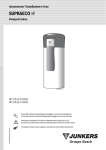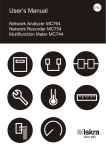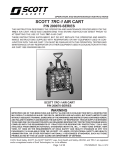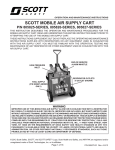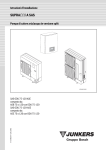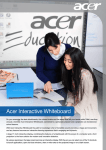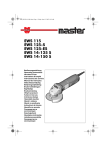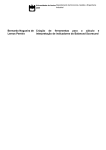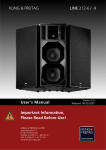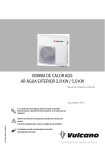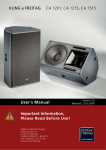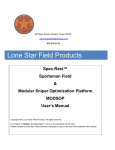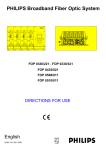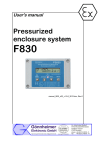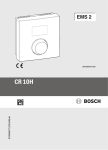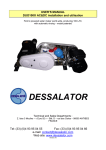Download Bosch Heat Pump User Manual
Transcript
Installation and operating instructions SUPRAECO W Heat pump 6720645393-00.1V HP 270... Please read the installation instructions before installing the appliance! Please read the operating instructions before commissioning the appliance! 6 720 646 161 (2012/04) BD-en Please observe the safety instructions in the operating instructions! The installation location must meet the requirements for sufficient ventilation! Installation must only be carried out by an authorised contractor! Table of Contents Table of Contents 1 Key to symbols and safety instructions . . . . . . . . . . . . . . . . . . . 3 1.1 Key to symbols . . . . . . . . . . . . . . . . . . . . . . . . . . . . . . . . . 3 1.2 Safety instructions . . . . . . . . . . . . . . . . . . . . . . . . . . . . . . 3 2 Standard delivery . . . . . . . . . . . . . . . . . . . . . . . . . . . . . . . . . . . . . 4 3 Information about the appliance . . . . . . . . . . . . . . . . . . . . . . . . . 5 3.1 Intended use . . . . . . . . . . . . . . . . . . . . . . . . . . . . . . . . . . 5 3.2 Overview of boiler types . . . . . . . . . . . . . . . . . . . . . . . . . 5 3.3 Type plate . . . . . . . . . . . . . . . . . . . . . . . . . . . . . . . . . . . . . 5 3.4 Description of appliance . . . . . . . . . . . . . . . . . . . . . . . . . 5 3.5 Accessories (not included in standard delivery) . . . . . . 5 3.6 Dimensions and minimum clearances . . . . . . . . . . . . . . 6 3.7 Appliance layout . . . . . . . . . . . . . . . . . . . . . . . . . . . . . . . 7 3.8 Electrical wiring diagram . . . . . . . . . . . . . . . . . . . . . . . . . 8 3.9 Refrigerant circuit . . . . . . . . . . . . . . . . . . . . . . . . . . . . . . 9 3.10 Safety, control and protective devices . . . . . . . . . . . . 10 3.10.1 High-pressure/low-pressure pressure switch . . . . . . 10 3.10.2 High limit safety cut-out . . . . . . . . . . . . . . . . . . . . . . . . 10 3.10.3 Temperature sensor for air inlet . . . . . . . . . . . . . . . . . 10 3.11 Corrosion protection . . . . . . . . . . . . . . . . . . . . . . . . . . 10 3.12 Specification . . . . . . . . . . . . . . . . . . . . . . . . . . . . . . . . 11 3.13 System scheme . . . . . . . . . . . . . . . . . . . . . . . . . . . . . . 12 3.13.1 Heat pump for DHW heating with boiler support . . . . 12 3.13.2 Heat pump for DHW heating with solar thermal system support . . . . . . . . . . . . . . . . . . . . . . . . . . . . . . . 13 4 Transport and storage . . . . . . . . . . . . . . . . . . . . . . . . . . . . . . . 13 5 Installation . . . . . . . . . . . . . . . . . . . . . . . . . . . . . . . . . . . . . . . . . 14 5.1 Installation location . . . . . . . . . . . . . . . . . . . . . . . . . . . 14 5.2 Secure the appliance . . . . . . . . . . . . . . . . . . . . . . . . . . 14 5.3 Installing the air ducts . . . . . . . . . . . . . . . . . . . . . . . . . 15 5.3.1 Open flue operation . . . . . . . . . . . . . . . . . . . . . . . . . . . 15 5.3.2 Functioning with outside air . . . . . . . . . . . . . . . . . . . . 15 5.4 Installation . . . . . . . . . . . . . . . . . . . . . . . . . . . . . . . . . . 15 5.5 Connection for the internal indirect coil . . . . . . . . . . . 16 5.6 DHW circulation . . . . . . . . . . . . . . . . . . . . . . . . . . . . . . 16 5.7 Condensate hose connection . . . . . . . . . . . . . . . . . . . 16 5.8 Expansion vessel (accessories not included in standard delivery) . . . . . . . . . . . . . . . . . . . . . . . . . . . . . 16 5.9 Filling the storage tank . . . . . . . . . . . . . . . . . . . . . . . . 16 5.9.1 Water characterisitcs . . . . . . . . . . . . . . . . . . . . . . . . . . 17 6 Electrical Connections . . . . . . . . . . . . . . . . . . . . . . . . . . . . . . . 17 6.1 Appliance's electrical connection . . . . . . . . . . . . . . . . 18 7 Commissioning . . . . . . . . . . . . . . . . . . . . . . . . . . . . . . . . . . . . . 18 7.1 Before commissioning . . . . . . . . . . . . . . . . . . . . . . . . . 18 7.2 Switching the appliance on/off . . . . . . . . . . . . . . . . . . 18 8 Operation . . . . . . . . . . . . . . . . . . . . . . . . . . . . . . . . . . . . . . . . . . 18 8.1 Working display . . . . . . . . . . . . . . . . . . . . . . . . . . . . . . 18 8.2 Working modes . . . . . . . . . . . . . . . . . . . . . . . . . . . . . . 18 2 8.3 8.3.1 8.3.2 8.3.3 8.3.4 8.4 8.5 8.5.1 8.5.2 8.5.3 8.5.4 8.5.5 8.5.6 8.6 8.7 8.8 8.9 8.10 9 „Operating“ menu . . . . . . . . . . . . . . . . . . . . . . . . . . . . . 19 „manual“ mode . . . . . . . . . . . . . . . . . . . . . . . . . . . . . . . 19 „P1“, „P2“ and „P3“ modes . . . . . . . . . . . . . . . . . . . . . . 19 „Full“ mode . . . . . . . . . . . . . . . . . . . . . . . . . . . . . . . . . . 19 „Off“ mode . . . . . . . . . . . . . . . . . . . . . . . . . . . . . . . . . . . 19 Setting the DHW temperature . . . . . . . . . . . . . . . . . . . 19 „Main“ menu . . . . . . . . . . . . . . . . . . . . . . . . . . . . . . . . . . 20 „Mode“ function - heating modes . . . . . . . . . . . . . . . . . 20 „Prog“ function - Timetable operation programming . 21 „Leg“ function - automatic thermal disinfection . . . . . 22 „Set“ function - adjustments . . . . . . . . . . . . . . . . . . . . . 23 „Purg“ function - purge . . . . . . . . . . . . . . . . . . . . . . . . . 23 „Info“ function - information . . . . . . . . . . . . . . . . . . . . . 23 Troubleshooting . . . . . . . . . . . . . . . . . . . . . . . . . . . . . . 23 Factory configurations . . . . . . . . . . . . . . . . . . . . . . . . . 24 Selecting the temperature units - „°C“ or „°F“ . . . . . . . 24 Setting the time and day of the week . . . . . . . . . . . . . . 24 Controls . . . . . . . . . . . . . . . . . . . . . . . . . . . . . . . . . . . . . 25 Environment / disposal . . . . . . . . . . . . . . . . . . . . . . . . . . . . . . . 25 10 Maintenance . . . . . . . . . . . . . . . . . . . . . . . . . . . . . . . . . . . . . . . . 26 10.1 General inspections . . . . . . . . . . . . . . . . . . . . . . . . . . . . 26 10.2 Performance check . . . . . . . . . . . . . . . . . . . . . . . . . . . . 26 10.3 Checking/replacing the magnesium anode . . . . . . . . . 26 10.4 Cleaning . . . . . . . . . . . . . . . . . . . . . . . . . . . . . . . . . . . . . 26 10.5 Condensate hose . . . . . . . . . . . . . . . . . . . . . . . . . . . . . . 26 10.6 Safety valve . . . . . . . . . . . . . . . . . . . . . . . . . . . . . . . . . . 26 10.7 Refrigerant circuit . . . . . . . . . . . . . . . . . . . . . . . . . . . . . 27 10.8 High limit safety cut-out . . . . . . . . . . . . . . . . . . . . . . . . 27 10.9 Draining the storage tank . . . . . . . . . . . . . . . . . . . . . . . 27 11 Display . . . . . . . . . . . . . . . . . . . . . . . . . . . . . . . . . . . . . . . . . . . . . 28 11.1 Faults that are shown on the display . . . . . . . . . . . . . . 28 11.2 Displays . . . . . . . . . . . . . . . . . . . . . . . . . . . . . . . . . . . . . 28 SUPRAECO W – 6 720 646 161 (2012/04) Key to symbols and safety instructions 1 Key to symbols and safety instructions 1.1 Key to symbols Warnings Warnings in this document are framed and identified by a warning triangle which is printed on a grey background. Electrical hazards are identified by a lightning symbol surrounded by a warning triangle. Keywords indicate the seriousness of the hazard in terms of the consequences of not following the safety instructions. • NOTICE indicates that material damage may occur. • CAUTION indicates that minor to medium injury may occur. • WARNING indicates that serious injury may occur. • DANGER indicates possible risk to life. Important information Important information in cases where there is no risk of personal injury or material losses is identified by the symbol shown on the left. It is bordered by horizontal lines above and below the text. Additional symbols Symbol B Æ • – Meaning a step in an action sequence a reference to a related part in the document or to other related documents a list entry a list entry (second level) Table 1 1.2 Safety instructions Installation B Installation must only be carried out by an authorised contractor. B Do not install the appliance in the following locations: – outside – in locations prone to corrosion – in locations with a temperature below +5 °C – in potentially explosive locations. B Check the tightness of all hydraulic connections before connecting the appliance to the power supply. B Wait until the appliance is at the installation location to remove it from its original packaging. Danger of scalding B Possible to operate with temperatures higher than 60 °C. Please install a thermostatic mixing valve on domestic hot water outlet connection. Maintenance B The operator is responsible for the safety and environmental compatibility of the appliance as well as its maintenance. B Only authorised contractors are permitted to maintain this appliance. B Isolate the appliance from the power supply before performing any maintenance work. Maintenance and repairs B Repairs may only be carried out by an authorised heating contractor. Faulty repairs may pose a danger to the operator and cause malfunctions in the appliance. B Only original spare parts must be used. B Have an authorised contractor perform an annual inspection and maintain the appliance as needed. Room/inlet air Keep the inlet air free of contaminants. It must not contain any of the following substances: • corrosive substances (ammonia, sulphur, halogen products, chlorine, solvents) • fatty or explosive substances • aerosol concentrations Do not connect any other exhaust system to the appliance ventilation system. Refrigerant B Please observe the relevant environmental regulations when using and reusing refrigerant. Do not allow refrigerant to be discharged into the environment. Use the refrigerant R134a. It is non-flammable and does not have a destructive impact on the ozone layer. B Before working on parts of the refrigerant circuit, remove the refrigerant to ensure work safety. Use HFC-134a and PAG-ÖL for maintenance purposes. It contains fluorinated greenhouse gas and is rated with a greenhouse potential of 1300 in the Kyoto Protocol. Instructions to the customer B Explain to the customer how the appliance works and how to operate it. B Advise the customer that he/she must not make any modifications to the appliance or carry out any repairs on it. Damage due to operator error Operator errors can lead to injuries and/or material losses. B Ensure that children never operate this appliance unsupervised or play with it. B Ensure that only individuals who can operate this appliance correctly have access to it. SUPRAECO W – 6 720 646 161 (2012/04) 3 Standard delivery 2 Standard delivery 1 2 6720645393-03.3V Fig. 1 [1] [2] 4 Heat pump Set of printed documents for the appliance SUPRAECO W – 6 720 646 161 (2012/04) Information about the appliance 3 Information about the appliance Appliances of the HP270 series are heat pumps which use the energy in the ambient air for domestic hot water (DHW) heating. 3.5 Accessories (not included in standard delivery) Description Fixation Brackets to fix ventilation pipes Part number 7 746 901 002 Expansion vessel 12l Expansion vessel 18l Expansion vessel 25l 7 747 204 675 "T" for inlet air source selection 7 746 900 714 Shut-off valve / check valve ¾ “ 7 709 500 048 Shut-off valve / check valve 1“ 7 709 500 080 Table 2 Weather louvre 7 719 003 334 [HP] Heat pump [270] Storage tank capacity [-1] Version [E] Electronic control unit [1] Number of internal indirect coils in the storage tank [F] Floor installation [I] Indoor air intake [V] Vertical installation [S] Side connections Roof outlet 7 719 003 366 3.1 Intended use The appliance may only be used for DHW heating. Using the appliance for any other purpose will be considered incorrect use. Junkers accepts no liability for any damage resulting from such use. The appliance is not suitable for industrial applications. It is approved for household use only. 3.2 Overview of boiler types HP 270 3.3 -1 E 1 F I V S Type plate The type plate is located on the rear side of the appliance. There you will find details on the appliance performance, part numbers, approval data, the coded data of manufacture (FD) and other specifications. 3.4 7 747 204 676 7 747 204 677 Flexible insulated (thermal and acoustic) ducts - 7 719 003 329 10m Air inlet and air outlet ducts 500 mm 7 746 900 698 Air inlet and air outlet ducts 1000 mm 7 746 900 702 Air inlet and air outlet ducts 2000 mm 7 746 900 706 45° bend 7 746 900 690 90° bend 7 746 900 694 Table 3 Description of appliance Appliance for DHW heating with the following features: • Glass-lined steel storage tank with thermal insulation using rigid polyurethane foam. • DHW storage tank corrosion-protected using internal magnesium anode. • Separate refrigerant and DHW circuits. • Heat pump automatically stops in the operating mode "Heat pump"1) if the air inlet temperature is below +5 °C or above 35 °C • High-pressure/low-pressure pressure switch to protect the refrigerant circuit. • R134a used as the refrigerant. • DHW temperatures between 30 °C and 70 °C (the factory setting for the DHW temperature is 50 °C). 1) Æ Section 8.5.1 SUPRAECO W – 6 720 646 161 (2012/04) 5 Information about the appliance Dimensions and minimum clearances 60 25 390 724 745 160 362 666.5 296 580 680 865 1225 1800 3.6 6720645393-05.2V Fig. 2 6 Appliance dimensions SUPRAECO W – 6 720 646 161 (2012/04) Information about the appliance 3.7 Appliance layout 11 12 13 26 6 10 9 5 14 23 25 15 6 24 16 5 22 18 20 21 17 3 4 7 2 8 1 3 4 27 2 19 1 6720645393-06.1V Fig. 3 [1] [2] [3] [4] [5] [6] [7] [8] [9] [10] [11] [12] [13] [14] [15] [16] [17] [18] [19] [20] [21] [22] [23] [24] [25] [26] [27] Heat pump Cold water inlet - G1¼ “ Internal indirect coil outlet - G1“ Internal indirect coil inlet - G1" Sensor well for temperature sensor (data for programming unit for the solar thermal system or central heating) DHW circulation inlet - G3/4" DHW outlet G1" Internal indirect coil Thermal insulation Cold water inlet to condenser Cold water outlet from condenser Air fan Evaporator Condenser (gas/water heat exchanger) Compressor Sensor well for DHW temperature sensor Magnesium anode Electric heating insert ON/OFF switch Adjustable feet (3x) Air outlet aperture Air inlet aperture Condensate outlet DHW circulation pump Front casing Housing ring Housing lid Fastening for housing lid SUPRAECO W – 6 720 646 161 (2012/04) 1 2 menu - + ok 3 6720645393-01.1V Fig. 4 [1] [2] [3] User interface Display Setting buttons Function/fault display for appliance 7 Information about the appliance 3.8 Electrical wiring diagram 14 1 2 3 13 12 4 M M 10 11 5 6 7 9 M 8 6720646160-20.1V Fig. 5 [1] [2] [3] [4] [5] [6] [7] [8] [9] [10] [11] [12] [13] [14] 8 Temperature sensor for air inlet Storage tank temperature sensor for DHW Storage tank temperature sensor for cold water Power cable High-pressure pressure switch Capacitor for compressor Compressor Temperature controller for compressor Low-pressure pressure switch DHW circulation pump Air fan Resistor Resistor for high-limit safety cut-out Control unit SUPRAECO W – 6 720 646 161 (2012/04) Information about the appliance 3.9 Refrigerant circuit The refrigerant circuit is a closed system in which the refrigerant R134a circulates as a heat transfer medium. The evaporator transfers the heat from the air to the refrigerant circuit, and the refrigerant evaporates into a gas. The compressor compresses the refrigerant R134a, thus increasing its temperature. Then the heat is transferred via a heat exchanger, also referred to as a condenser, to the storage tank water. The refrigerant R134a condenses in the process. R134a flows through the expansion valve in liquid state with decreasing pressure. Then it is routed back to the evaporator. 1 2 5 16 15 3 14 4 18 17 13 12 11 6 7 19 10 8 9 6720646160-23.3V Fig. 6 [1] [2] [3] [4] [5] [6] [7] [8] [9] [10] [11] [12] [13] [14] [15] [16] Air fan Evaporator Compressor Condenser (gas/water heat exchanger) NTC temperature sensor (air inlet) DHW connection Temperature sensor aperture (data for programming unit for solar thermal system or central heating) Internal indirect coil Cold water inlet Electric heating insert NTC temperature sensor (top of storage tank) DHW circulation pump NTC temperature sensor (bottom of storage tank) Dry filter Expansion valve Low-pressure pressure switch SUPRAECO W – 6 720 646 161 (2012/04) [17] Water purge [18] High-pressure pressure switch [19] Magnesium anode 9 Information about the appliance 3.10 Safety, control and protective devices 3.10.1 High-pressure/low-pressure pressure switch The pressure switch protects the refrigerant circuit from overpressure. The pressure switch switches off the appliance in the event of overpressure. An automatic reset occurs as soon as the pressure in the refrigerant circuit has been regulated. 3.10.2 High limit safety cut-out The high-pressure safety cut-out ensures that the storage tank's water temperature does not exceed the prescribed limit. If the temperature rises above the limit, the heating process is interrupted. The reset is performed manually by an authorised contractor. 3.10.3 Temperature sensor for air inlet The temperature sensor measures the temperature of the inlet air in the evaporator. If the measured value is outside operating temperature range, DHW production automatically switches from "Combi" operating mode to "Electrical" operating mode. If the appliance is in "Heat" operating mode, production is stopped until the measured value is within operating temperature range. 3.11 Corrosion protection The internal wall of the DHW storage tank is glass lined (double coating). As an additional corrosion protection measure, the storage tank is equipped with an internal magnesium anode. It must be inspected at regular intervals and replaced if necessary. First maintenance must be performed 6 months after installation. In regions with more corrosive water, special safety measures (filter, etc.) must be taken, and the magnesium anode must be serviced at shorter time intervals. 10 SUPRAECO W – 6 720 646 161 (2012/04) Information about the appliance 3.12 Specification Unit HP270...O... kW – kW 2.0 3.5 2.0 m3/h 350/330 °C +5 ... +35 Refrigerant R134a g 375 Maximum pressure bar 27 l kW m2 °C l/day bar/MPa kWh/day 270 2.0/4.0 1.5 60/70 1270 10/1 0.96 Power supply voltage V 230 (+10%/-15%) Frequency Hz 50 Electric current (without/with electric heating insert) Total power consumption Power consumption (without electric heating insert) Protection class IP rating (without/with piping) General data A kW kW IP 2.6/11.3 2.6 0.6 I 21/24 dB(A) 45 Dimensions, W x H x D mm 724 × 1825 × 745 Net weight (without packaging) kg 143 Operation Heating output (without electric heating insert)1) Performance coefficient (COP)1) Heating output of integrated electric heating insert Air inlet Air flow rate (without/with piping) Operating temperature Compressor Domestic Hot Water Storage tank capacity Maximum heating output without/with electric heating insert Area of heat exchanger (internal indirect coil) Maximum water temperature without/with electric heating insert Maximum DHW flow rate1) Maximum operating pressure Cooling constant in 24 hours, as per DIN 4753 Part 82) Data on the electrical connecting leads Sound pressure level (at a distance of 1 m) Table 4 1) As per EN255-3, 20 °C air, DHW heating from 15 °C to 45 °C 2) 20 °C air, DHW temperature 55 °C SUPRAECO W – 6 720 646 161 (2012/04) 11 Information about the appliance 3.13 System scheme 3.13.1 Heat pump for DHW heating with boiler support 10 12 3 9 6 1 7 8 13 2 3 4 5 11 6720646160-24.2V Fig. 7 [1] [2] [3] [4] [5] [6] [7] [8] [9] [10] [11] [12] [13] 12 Additional heating element (f.i. gas boiler) DHW circulation pump Cold water inlet Shut-off valve Check valve Safety valve Expansion vessel Drain set Heat pump DHW connection Outlet siphon Mixing valve Integrated electric heating element SUPRAECO W – 6 720 646 161 (2012/04) Transport and storage 3.13.2 Heat pump for DHW heating with solar thermal system support 1 10 2 9 14 12 3 13 6 7 8 15 7 3 4 5 11 6720646160-28.2V Fig. 8 [1] [2] [3] [4] [5] [6] [7] [8] [9] [10] [11] [12] [13] [14] [15] 4 Thermal solar collectors Solar programming unit Cold water inlet Shut-off valve Check valve Safety valve Expansion vessel Drain set Heat pump DHW connection Outlet siphon Solar pump station Container for safety valve drain Mixing valve Integrated electric heating element Transport and storage NOTICE: Transport damage! B Avoid tilting the appliance at an angle of more than 45°. B Take care when handling the appliance. B To avoid dropping the appliance and damaging internal components, do not pivot the appliance. SUPRAECO W – 6 720 646 161 (2012/04) NOTICE: Transport damage! B To avoid transport damage, wait until the appliance is at the installation location to remove the protective packaging. B Transport and set down the appliance carefully. Jerky movements can damage the internal glass-lined coating, the components and their connections or the external casing. B Use straps to prevent the appliance from becoming scratched. B Use suitable means of transport to bring the appliance to the installation location (special car, pallet truck, etc). General The appliance is delivered on a single pallet and is protected against transport damage by special packaging. Always store and transport the appliance in its original packaging, in vertical position (check "tilt label" prior to installation) and with the storage tank empty. Ambient temperatures of -20 °C to +60 °C are permissible for storage and transport. 13 Installation • The plinth of the appliance must be strong enough (the appliance weighs about 400 kg when the storage tank is filled, with the weight distributed equally over its 3 adjustable feet). To ensure faultless operation and easy access to all components and connections for maintenance and repairs, maintain the minimum clearances specified in Fig. 10. 430 400 2200 500 6720646160-45.1V Fig. 9 Manual transport Fig. 10 Recommended minimum clearances (mm) 5.2 Secure the appliance B Check the colour of the tilt label. If it is not blue in the top arrow, remove the shrink wrap and external protective packaging. Installation B Installation must only be carried out by an authorised contractor. B The heat pump installation must follow the applicable regulations. B Check that all pipe connections are intact and have not shaken loose during transportation. B Check the colour of the "tilt label" on the rear side of the appliance's packaging. If the label is blue, the appliance cannot be installed and should be returned on it‘s original packaging. Transport Control Int´l Gmbh Am Knick 9,22113 Oststeinbek Tel: 0049 40 713 84 02 Fax: 0049 40 713 24 94 TIP BLUE ARROW COUNTAIBEDS INDICATE IN TIPPED NER MISHAND S ORWAS LED N TEL L Transp Am ort Knick Tel: Contro Fax: 0049 9,22113 0049 40 l Int´l Oststein 40 713 Gmbh 713 84 24 02 bek 94 TIP N TELL BLUE BEDS IN ARROW INDICATES COUNTAINER WAS TIPPED OR MISHANDLED N L TEL TIP MADE IN U.S.A. PATENT NO.3,926,144 5 MADE IN U.S.A. PATENT NO.3,926,144 TIP N TELL BLUE BEDS IN ARROW INDICATES COUNTAINER WAS TIPPED OR MISHANDLED MADE IN U.S.A. PATENT NO.3,926,144 To bring the appliance into position at the installation location, place straps around the storage tank. 6720645393-04.2V IN S BEDS WAS INDICATE BLUE NER OR LED ARROW COUNTAI TIPPED MISHAND Gmbh bek l Int´l 02 Oststein 84 94 Contro713 24 40 713 ort 9,22113 40 0049 Knick Transp 0049 Am Tel: Fax: MADE IN U.S.A. PATENT NO.3,926,144 NOTICE: Damage from straps! B Remove front casing (Æ Fig. 3, [24]). B Make sure that the straps do not scratch or make indentations on the surface of the appliance. B Do not fasten the straps at the resistor (Æ Fig. 3, [17]) or at the temperature sensor aperture (Æ Fig. 3, [4]). Transport Control Int´l Gmbh Am Knick 9,22113 Oststeinbek Tel: 0049 40 713 84 02 Fax: 0049 40 713 24 94 6720646160-46.1V 5.1 Installation location Please note the following when choosing the installation location: • The appliance must be installed in a dry, frost-free room. Optimum appliance performance is achieved at room temperatures between +5 °C and +35 °C. • Check that the appliance‘s installation area has the required resistance and alignment. • The air outlet and air inlet must not be in locations where there is a risk of explosion from gas, steam or dust. • If open flue gas appliances are already installed at the installation location, the appliance may not be operated with room air circulation. Use of an inlet pipe for fresh air or another facility ensuring that the inlet air is separate from the gas appliance is mandatory. • Ensure that condensate drains correctly. 14 Fig. 11 B Lift the appliance from its pallet. B To correctly align the appliance at the installation location, adjust the height of the adjustable feet. To ensure that the system operates faultlessly and the condensate drains, the appliance must be aligned vertically. The appliance must not tilt more than 1°, preferably in the direction of the condensate drain. NOTICE: Damage in the external casing! B Do not tilt the appliance more than 20°. SUPRAECO W – 6 720 646 161 (2012/04) Installation 5.3 Installing the air ducts Inlet air can be taken from the room where the appliance is installed, from another room or from the outside. In the last two cases, ducts must be assembled in the air inlet. C1 C2 L2 L4 To ensure maximum appliance performance and avoid condensation in the outer ducts surface, use thermally and acoustically insulated ducts. LT1 Choose a room for the air inlet. Observe the average air temperature and maximum required air flow rate (Æ Tab. 4). To achieve as little air resistance as possible, install the air inlet and air outlet ducts (Ø 160 mm) as straight as possible. The length of the ducts for the air inlet and air outlet must not exceed 6 m. Do not install more than two 90° bends. For each additional bend, reduce the duct length by 1 m. Duct length for the air inlet and air outlet Reduction for each 90° bend LT 2 L3 L1 Ø 160 mm 6m 1m Table 5 LT1 = L1+C1+L2 LT2 = L3+C2+L4 To ensure that condensate forming in the air inlet and air outlet ducts drains from the appliance: B Install air ducts at a slight angle to the opposite side of the air inlet and air outlet apertures on the top side of the appliance. B Limit the pressure drop in the lines to 10 Pa to ensure a minimum inlet air flow rate of 330 m3/h as well as the stated heating output. Fig. 13 Corresponding duct length (L) 5.3.1 Open flue operation If the heat pump can be operated using the air in the installation room, ensure that the room has a volume greater than 20 m3. 5.3.2 Functioning with outside air When using outside air, assure that the ducts are protected with the correct accessories. 2 L = LT1 + LT2 Ø 160mm: L ≤ 6m 5.4 1 6720645393-08.3V Installation NOTICE: Damage to the ducts due to improper handling! B Do not allow ducts to become contaminated during installation. B If necessary, flush the ducts with water prior to commissioning. It is advisable to purge the installation beforehand, the presence of dirt may reduce the flow and, in extreme cases, cause a blockage. It is recommended that a water filter be installed at the the appliance's cold water inlet. 6720645393-07.2V Fig. 12 [1] [2] Air inlet Air outlet NOTICE: Corrosion damage to the storage tank's connections! If the connections are copper: B Use an isolation fitting1) for the hydraulic connection. This extends the service life of the magnesium anode. 1) Accessory not included in standard delivery B Determine the nominal diameter of the room's water installation. Please note the current water pressure and the expected pressure drop. B Carry out the water installation in accordance with the applicable regulations. Please observe the local regulations on DHW installations. B The water pipes can be rigid or flexible. To avoid corrosion, take into account the behaviour of the materials used in the pipework and the connections. SUPRAECO W – 6 720 646 161 (2012/04) 15 Installation To avoid heat loss and improve appliance efficiency: B Insulate all water connections. Safety valve1) B Install a safety valve at the appliance's cold water inlet. If the water inlet pressure is higher than 8 bar - 80% the allowable maximum value (10 bar) -, install a check valve. The safety valve is controlled as soon as the water pressure in the appliance is more than 10 bar. In this case it must be possible to divert the drain to a container. NEVER SEAL OFF THE SAFETY VALVE'S DRAIN. Do not install any accessories between the safety valve and the appliance's cold water inlet. NOTICE: The safety valve drain tube must be installed in a frost free environment and downwards oriented. 5.5 Connection for the internal indirect coil The appliance is equipped with an internal indirect coil for backup heating from solar thermal or central heating systems. 1 2 6720646160-26.1V Fig. 14 Condensate drain [1] [2] Condensate drain Outlet siphon 5.8 If DHW temperature in the tank reaches 80 °C, the external controller must switch off the backup circuit. This is to prevent damage to the heat pump's refrigerant circuit or failure of the safety temperature limiter. WARNING: Danger of scalding! Hot water can cause serious scalding. B Warn occupants of risk of scalding. B Install a thermostatic mixing valve to limit the hot water outlet temperature. If the internal indirect coil is not used: B Do not remove the plugs from the internal indirect coil's inlet and outlet apertures. DHW temperature sensor in the storage tank B Install DHW temperature sensor in the correct pipe (Æ Fig. 3, [4]). B Insulate the pipe to prevent heat loss. 5.6 Expansion vessel (accessories not included in standard delivery)1) To prevent water loss from the safety valve, a DHW expansion vessel can be installed. B Install the expansion vessel at the cold water connection between the storage tank and the safety assembly. Table 6 serves as a reference for the selection of the expansion vessel. The capacity of the expansion vessel must be selected subject to the water pressure in the system. Details refer to a storage tank temperature of 60 °C. Storage tank type Water pressure in the system 2 12 l 3 18 l 4 25 l 2 12 l 3 12 l 4 18 l 2 12 l 3 12 l 4 18 l DHW circulation With regard to the output, DHW circulation should only be used when it is really needed. To avoid heat loss through a circulation system connected to the DHW distributor system, this system must be controlled using a valve or a similar device. Heat recovering time will be higher when using a recirculating system. 5.7 Safety valve (max. pressure) Capacity of the expansion vessel corresponding to the switch-on pressure of the safety valve 6 bar HP 270... 8 bar 10 bar Condensate hose connection The condensate is drained on the rear side of the appliance. B Connect the condensate hose1) to the condensate drain (Fig. 14, [1]) to allow the condensate to drain freely. B Drain condensate via an outlet siphon (Fig. 14, [2]). Table 6 5.9 Filling the storage tank NOTICE: Damage to the appliance! B Prior to commissioning the appliance, fill the storage tank with water and ventilate it. 1) Accessory not included in standard delivery 16 SUPRAECO W – 6 720 646 161 (2012/04) Electrical Connections Check if the purge valve outlet is downwards oriented. If not: B Rotate the purge valve clockwise (tightening) to assure that the outlet is downwards oriented. B Open DHW connection (Fig. 6, [6]) and one or more hot water taps. B Open storage tank cold water inlet (Fig. 6, [9]). Storage tank filling starts. B Close hot water taps only when water flow is free of air pockets. B Connect the appliance to the power supply via a connection socket with an earth conductor. B Move main switch (on the rear side of the appliance above the power cable (Æ Fig. 3, [18])) to "I". B Rotate circulation pump speed selector to position „III“. B Reopen purge valve for a few seconds to assure the complete purge of the system.. B Rotate circulation pump speed selector to position „I“. 5.9.1 Water characterisitcs Usage of water with unsuitable characterisitcs can result in prematurely failing. Water hardness (°dH) Water treatment 3,0 - 11,2 Not required Table 7 Water hardness pH Water treatment 6,5 - 9,5 Not required < 6,5 or > 9,5 Required Table 8 pH value Water conductivity for sacrificial anodes 130 μS/cm - 1500 μS/cm Table 9 Water conductivity Enamelled tanks must not be used with completely desalted, distilled or de-ionised potable water. 6720646160-51.1V Fig. 15 Circulation pump 6 B Activate „Purg“ function (Æ page 28, section 8.5.6). CAUTION: Risk of scalding! B Ensure that draining water from the purge valve presents no risk to people or property. Only an authorised contractor is permitted to install the appliance, connect it to the mains, install the air outlet/ inlet and commission the appliance. B Open purge valve (Æ Fig. 16, [1]) until water drops out through the purge valve outlet. Ensure that water drains correctly. 1 Electrical Connections 2 DANGER: Risk of electric shock! B Isolate the appliance from the power supply using the fuse or another protective device before carrying out any work on electrical parts. DANGER: Risk of electric shock!The capacitor must discharge after the appliance has been switched off. B Wait at least 5 minutes. Fig. 16 Purge valve [1] [2] Purge valve Condenser (gas/water heat exchanger) B Close purge valve. B Wait for about 5 minutes until „Purg“ mode goes off. B Rotate circulation pump speed selector to position „I“. Filling procedure is concluded. DANGER: Risk of electric shock!To ensure compliance with all safety requirements, a defective connecting cable may only be replaced by an authorised contractor. All control, monitoring and safety equipment of this appliance is fully wired and tested. The appliance is set at the factory to a power supply of 230 V. If, after a few minutes of operation, display shows „E09“, you should: B Reset the appliance (Æ page 23, paragraph „Resetting the system“). B Rotate circulation pump speed selector to position „III“. B Activate „Purg“ function (Æ page 28, section 8.5.6). SUPRAECO W – 6 720 646 161 (2012/04) 17 Commissioning NOTICE: Fuse protection! 8 Operation B The wiring diagram must show a separate connection for the appliance.There must be a 30 mA RCD and earth conductor. 1 The appliance is already equipped with a cable for the power supply. Power is supplied via the connecting cable (2 m) and an earthed wall socket (230 V AC/50 Hz). 2 menu - + ok 3 For safety and maintenance purposes, ensure that the socket is accessible after installation. 6720645393-01.1V Fig. 17 Control panel 6.1 Appliance's electrical connection The electrical connection must meet the current standards for electrical installations in the country of use. [1] [2] [3] Display Selection keys Indicator light/ Device error indicator 1 2 3 4 5 6 7 B Connect the appliance to the power supply via a connection socket with an earth conductor. 8 9 16 10 15 7 Commissioning 7.1 Before commissioning NOTICE: Starting up the appliance when it has not been filled with water will damage it beyond repair! B Only operate the appliance once it has been filled with water. B Check whether the storage tank is filled with water. B Check all fittings for leaks. B Check the electrical connection. 7.2 Switching the appliance on/off Switching ON B Move main switch (on the rear side of the appliance above the power cable (Æ Fig. 3, [18])) to "I". After the compressor start-up, the appliance should work, at least, for 5 minutes before it gets turned off again. Switching off B Move main switch to "0". NOTICE: Appliance damaging! Negative temperatures can lead to water freezing. B Do not disconnect power supply. B Move main switch to „I“. B Switch the appliance to „Off“ mode (Æ section 8.3.4, page 19). -orB Drain the appliance. 11 14 12 13 6720645393-10.1V Fig. 18 Display [1] [2] [3] [4] [5] [6] [7] [8] [9] [10] [11] [12] [13] [14] [15] [16] 8.1 Display Heating in heat pump mode External heat (solar or boiler) Information Parameter adjustment entry Error indicator „Service“ menu entry Days of the week „auto/man“ functioning Indicator light „Prog“ menu entry Clock adjustment Timetable Consumption Storage tank sensor positions „anti-freeze“ function Working display Visible display symbol Device functioning. Visible display symbol Device inactive (water temperature remains at previously selected temperature). 8.2 Working modes Visible display symbol „ “ Operating periods in accordance with defined programming (P1, P2 or P3). Visible display symbol „ “ Permanent operation (24 h/7 days) without defined programming or „Full“ mode. 18 SUPRAECO W – 6 720 646 161 (2012/04) Operation 8.3 „Operating“ menu "Full" mode activation reduces device efficiency, and should only be selected in the event of need for a rapid increase in water temperature. Access the „Operating“ menu B Press the „menu“ key for no longer than 3 seconds. menu - + ok <3s 6720646160-14.1V Fig. 19 Accessing the „Operating“ menu 6720646160-08.1V Accessing the „Operating“ menu provides access to the following modes of operation: • manual • P1 • P2 • P3 • Full • Off B Use the „+“ or „-“ keys to select the desired working mode. B Confirm using the „oK“ key To go back one menu: B Press the „menu“ key. -orB Do not press any key for the following 15 seconds. Fig. 21 „Full“ mode This mode permits setting the water temperature anywhere between 30 °C and 70 °C. Two heat sources are used simultaneously until the desired temperature is reached. Only electrical heat is used over 60 °C. Upon reaching the selected water temperature, the device exits „Full“ mode and returns to the mode previously selected. 8.3.4 „Off“ mode This operating mode disconnects the device. Electrical power is only activated for the „anti-freeze“ protection function, if necessary. 8.3.1 „manual“ mode In this working mode, the device functions 24 hours a day, 7 days a week, until it reaches a selected temperature. Used heat source is defined using the Mode function (Æ Chapter 8.5.1) of „Main“ menu. 6720646160-10.1V Fig. 22 Modo „Off“ „Anti-freeze“ function The electrical power is connected when the water temperature of the deposit reaches 5 °C. It is disconnected when the water temperature reaches 10 °C. 6720646160-37.1V Fig. 20 „manual“ mode 8.3.2 „P1“, „P2“ and „P3“ modes 8.4 Setting the DHW temperature The water temperature is factory-set at a value of 50 °C. „P1“ mode Selecting this menu causes the device to function during the predefined factory time periods (Æ „„P1“ period„, page 21). „P2“ and „P3“ mode Selecting this menu causes the device to function during user-defined time periods (Æ „„P2“ and „P3“ periods, page 21). 8.3.3 „Full“ mode In this mode, the device uses two heat sources simultaneously: the heat pump and electrical power. SUPRAECO W – 6 720 646 161 (2012/04) 19 Operation B Press the „+“ or „-“ keys until the desired value is reached. 6720646160-19.1V 6720646160-13.1V Fig. 23 Setting the temperature B Press the „ok“ key to confirm the selection. The selected temperature will blink 3x to signal confirmation. Fig. 25 „Mode“ function „Electrical“ mode In this mode, the only heat source used is electrical power. The selected value blinks until the selection is validated. If the selection is not validated within 10 seconds, the previously selected value will remain active. 8.5 „Main“ menu Accessing the „Main“ menu B Press the „menu“ key and hold it down for over 3 secs. menu - + ok 6720646160-07.1V Fig. 26 „Electrical“ mode This mode permits setting the water temperature anywhere between 30 °C and 70 °C. „Heat pump“ mode >3s Water heating is only assured while air inlet is between 5 °C and 35 °C. 6720646160-49.1V Fig. 24 Accessing the „Main“ menu Accessing the „Main“ menu provides access to the following functions: • Mode - „Heating modes“ • Prog - „Timetable operation programming“ • Leg - „thermal disinfection“ • Set - „adjustments“ • Purg - „purge“ • Info - „information“ B Use the „+“ or „-“ keys to select the desired menu. B Confirm using the „ok“ key 8.5.1 „Mode“ function - heating modes The „Mode“ function permits selection of 3 different heating modes: • „Electrical“ mode • „Heat pump“ mode • „Combi“ mode 6720646160-06.1V Fig. 27 „Heat pump“ mode This mode permits setting the water temperature anywhere between 30 °C and 60 °C. Very low temperatures trigger activation of the „anti freeze“ protection function (Æ page 19). „Combi“ mode This mode used two heat sources, depending on conditions: the heat pump or the electrical supply. 20 SUPRAECO W – 6 720 646 161 (2012/04) Operation „P2“ and „P3“ periods The heat pump functions at times preset by the user. 6720646160-09.1V Fig. 28 „Combi“ mode This mode permits setting the water temperature anywhere between 30 °C and 70 °C. If the water temperature inside the tank is less than 60 °C and the incoming air temperature is between -10 °C and +35 °C, the heat pump will be used as the sole heat source. The electrical power will be activated when these conditions are not achieved. 8.5.2 „Prog“ function - Timetable operation programming The „Prog“ function permits the heat pump to be programmed for operation based on the desired timetable only. 6720646160-35.1V Fig. 31 „P2“ and „P3“ periods Setting the operating periods to „P2“ and „P3“ 4 operating periods will be set in each of the functions: • 2 periods for days „1 to 5“ • 2 periods for days „6 to 7“ Definition of operating periods B Access the „P2“ or „P3“ functions (Æsection 8.3). B Press „ok“. Display shows the start schedule of the 1st operating period in blink mode. 6720646160-15.1V 6720646160-39.1V Fig. 29 „Prog“ function The „Prog“ function provides access to the following menus: • „P1“ period (days 1 to 5) • „P1“ period (days 6 to 7) • „P2“ period (days 1 to 5) • „P2“ period (days 6 to 7) • „P3“ period (days 1 to 5) • „P3“ period (days 6 to 7) Fig. 32 Start of 1st operating period B Use the „+“ and „-“ keys to define the operating start schedule. B Press „ok“. Blinking display shows operating stop schedule for the 1st period. B Use the „+“ and „-“ keys to define the operating duration. B Press „ok“. Blinking display shows the start schedule for the 2nd operating period. „P1“ period The heat pump functions during the predetermined factory times. No other type of alteration is possible: Days 1 - 5: [00:00 Æ 06:00] and [16:00 Æ 19:00] Days 6 - 7: [02:00 Æ 08:00] 6720646160-40.1V Fig. 33 Beginning of the 2nd operating period 6720646160-16.1V Fig. 30 „P1“ period SUPRAECO W – 6 720 646 161 (2012/04) If the start of the 2nd operating period is defined within the operating period of the 1st period, the end of operation of the 1st period will be adjusted to the newly defined value. 21 Operation B Use the „+“ and „-“ keys to define the operating start schedule of the 2nd period. B Press „ok“. Blinking display shows the operating stop schedule for the 2nd period. B Use the „+“ and „-“ keys to define the operating duration. B Press „ok“. Days „1 to 5“ are now set. 6720646160-17.1V Fig. 36 „Leg“ function The device is factory set with the function deactivated. Activation of the disinfection mode temporarily replaces any defined programming. 6720646160-41.1V WARNING: Beware of burns! Hot water can cause serious burns. Fig. 34 Start of 1st operating period for days „6 to 7“ If there‘s no need for a 2nd working period. B Select the start schedule and end of functioning for the same time. B Repeat the above described operations for the operating periods of days „6 and 7“. Completed definition of the 2nd operating period for days „6 and 7“ concludes the definition of the operating periods. B Thermal disinfection should only be performed outside normal working hours. B Warn all users of the danger of burns and the need to perform thermal disinfection. The disinfection process will run for a maximum period of 24h. After this time, if a temperature of 70 °C has not been reached (due to consumption of hot water during the disinfection period), the device will automatically return to the previously selected mode of functioning. Automatic activation of the „Leg“ function B Access the Leg function and press „ok“. Display with blinking indication „ “ active. B Press „+“. Display with blinking indication „ “ active. B Press „ok“. „Leg“ function activated and blinking 1st day of the week. 1 2 3 4 The hot water temperature is automatically set at 70 °C. 6720646160-38.1V Fig. 35 Definition of periods [1] [2] [3] [4] Start of 1st period End of 1st period Start of 2nd period End of 2nd period Switching off the operating period B Select the start schedule and end of functioning for the same time. The operating period will be switched off. 8.5.3 „Leg“ function - automatic thermal disinfection The „Leg“ function permits activation/deactivation of the thermal disinfection process. This bacteria elimination process should be performed at least once a week. Define the day of the week for disinfection. B Select the day, using the „+“ and „-“ keys. B Press „ok“. Define the time of disinfection B Select the time, using the „+“ e „-“ keys. B Press „ok“. Upon reaching a temperature of 70 °C, the device returns to the previously selected mode. Manual activation of the „Leg“ function B Access the „Leg“ function and press „ok“. Display with blinking indication „ “ active. B Press „ok“. „Leg“ function activated. The hot water temperature is automatically set at 70 °C. 22 SUPRAECO W – 6 720 646 161 (2012/04) Operation Upon reaching a temperature of 70 °C, the device returns to the previously selected mode. The disinfection process will not be repeated until it is reactivated. „reset“ consumption Displays with indication of cumulative consumption. B Press „-“. Displays with blinking „del“ indication. 8.5.4 „Set“ function - adjustments The „Set“ function permits adjustment of the following values: • Temperature units (Æ Chapter 8.8) • Time and day of the week (Æ Chapter 8.9). 6720646160-42.1V Fig. 40 „del“ function B Press „ok“. The meter restarts the count. 8.6 6720646160-18.1V Fig. 37 „Set“ function 8.5.5 „Purg“ function - purge „Purg“ function is an auxiliary for the system purging process. Fig. 38 „Purg“ function Troubleshooting This device is equipped with a troubleshooting function. Anomaly indication is performed by means of a code (Table 10, page 28) corresponding to the error indication symbol in the digital visor (Fig. 18, [6]) and the blinking of the functioning indicator light. In most cases, the device will only return to normal functioning following elimination of the cause of the malfunction and resetting of the device. To identify the malfunction, see Chapter 11. 6720801967 02 1V To activate „Purg“ function B Access „Purg“ function and press „OK“. B Circulation pump will start functioning. After 5 minutes the appliance returns to the operating mode previously selected. menu - + ok 8.5.6 „Info“ function - information The „Info“ function permits display of the cumulative consumption over the past 30 days. 6720646160-43.1V Fig. 41 Error code Resetting the system B Press the „ok“ key and hold it down for over 3 seconds. menu - + ok 6720646160-36.1V Fig. 39 „Info“ function Displaying the consumption B Access the „Info“ function and press „ok“. Displays cumulative consumption (in kWh). >3s 6720646160-21.1V Fig. 42 Resetting the system SUPRAECO W – 6 720 646 161 (2012/04) 23 Operation 8.7 Factory configurations Upon definition of the temperature units and timetable, the device will operate according to the factory set values. B Confirm the selection using the „ok“ key. The clock is set and the day of the week begins to blink. Heating mode: „Combi“ (Æ chapter 8.5.1) Manual functioning: „manual“ (Æ chapter 8.3) 6720646160-12.1V Fig. 46 Setting the day of the week 6720646160-37.1V Fig. 43 Initial menu 8.8 Selecting the temperature units - „°C“ or „°F“ Upon the 1st use, the user must select the temperature unit. B Press the „+“ or „-“ keys to set the day of the week. B Confirm the selection using the „ok“ key. By default, the first day of the week is Monday, the second is Tuesday, and so on. The definition of the 1st day of the week can be changed if desired. 6720646160-34.1V Fig. 44 Selecting the temperature units B Press the „+“ or „-“ keys to select the temperature unit. B Confirm the selection using the „ok“ key. 8.9 Setting the time and day of the week The „am/pm“ selection is only valid if „°F“ is selected as the unit of temperature. 6720646160-11.1V Fig. 45 Setting the time B Press the „+“ or „-“ keys to set the time. B Confirm the selection using the „ok“ key. Display shows the minute digits, blinking. B Press „+“ or „-“ keys to set the minutes. 24 SUPRAECO W – 6 720 646 161 (2012/04) Environment / disposal 8.10 Controls menu - + ok manual - + - + - + - + - + - + - + - + - + P1 P2 <3s menu - + P3 Full Off ok Mode Prog Leg >3s Set - + Purg menu - + - + - + Info ok >3s 6720646160-47.3V 9 Environment / disposal Environmental protection is a fundamental corporate strategy of the Bosch Group. The quality of our products, their economy and environmental safety are all of equal importance to us and all environmental protection legislation and regulations are strictly observed. We use the best possible technology and materials for protecting the environment taking account of economic considerations. Used appliances Used appliances contain valuable materials that should be recycled. The various assemblies can be easily dismantled and synthetic materials are marked accordingly. Assemblies can therefore be sorted by composition and passed on for recycling or disposal. Packaging We participate in the recycling programmes of the countries in which our products are sold to ensure optimum recycling. All of our packaging materials are environmentally compatible and can be recycled. SUPRAECO W – 6 720 646 161 (2012/04) 25 Maintenance 10 Maintenance DANGER: Risk of electric shock! B Isolate the appliance from the power supply using the fuse or another protective device before carrying out any work on electrical parts. B Remove magnesium anode. 10.1 General inspections Inspect the appliance regularly to identify possible malfunctions. B Keep the appliance's casing the installation location clean. B Dust the system regularly using a damp cloth. This way leaks can be identified and repaired at an early stage. B Check all fittings for leaks on a regular basis. 10.2 Performance check The temperature difference between the air inlet and the air outlet must be 5 - 7 °C. 6720800765-05.1V If the temperature difference is greater: B Check the air inlet and air outlet ducts (wrong air flow rate) Fig. 47 Checking state of magnesium anode If the temperature difference is smaller: B Notify a contractor or customer service (the appliance must be tested to improve its heating output). 10.4 Cleaning 10.3 Checking/replacing the magnesium anode The appliance is protected against corrosion by an internal magnesium anode. B Check and, if necessay, replace the magnesium anode. B Check and clean the evaporator regularly. B The air inlet and air outlet apertures must be unobstructed and accessible. B Check the air grille, air filter and air ducts regularly and clean them if necessary. 10.5 Condensate hose NOTICE: Damage to the appliance! The magnesium anode must be installed before commissioning the appliance. NOTICE: Damage to the appliance! Check the magnesium anode annually and replace if required. Appliances operated without this protection are excluded from our warranty. B Loosen the link between the tube of the condensers and the condenser collection parts. B Check for the presence of any dirt in the part and/or the tube. B Reassemble the link between the tube and the condenser collection part. 10.6 Safety valve B Open the safety valve at least once a month (Æ Fig. 48) to ensure that it is functional. The internal wall of the DHW storage tank is coated with a double glass lining. The coating is designed for normal quality water. When using more corrosive water, the warranty only applies if additional safety measures (f.i. dielectric joints) have been taken and the magnesium anode is checked more frequently. 1 To check the protective anode: B Isolate the appliance from the power supply. B Remove front casing. CAUTION: Risk of scalding! B Before removing the magnesium anode, drain about 75 litres of water from the storage tank. 2 6720608467-18.2AL Fig. 48 Safety valve [1] [2] Safety valve Drain CAUTION: Risk of scalding B Ensure that draining water from the safety valve presents no risk to people or property. 26 SUPRAECO W – 6 720 646 161 (2012/04) Maintenance 10.7 Refrigerant circuit NOTICE: Refrigerant leak! B Repairs to the refrigerant circuit (e.g. to the compressor, condenser, evaporator, expansion vessel) may only be carried out by an authorised contractor. 10.8 High limit safety cut-out The appliance is equipped with an automatic safety facility. This safety facility isolates the DHW storage tank from the power supply to prevent the risk of injury if the DHW storage tank water temperature rises above a certain limit. NOTICE: The temperature limiter may only be reset by an authorised contractor after the fault has been remedied. Resetting the high limit safety cut-out B Remove front casing (Æ Fig. 3, [24]). B Remove the protective cap from the resistor. B Press reset button all the way down ( Fig. 49, [1]). 1 2 6720646160-27.1V Fig. 49 Temperature controller [1] [2] Reset button Temperature controller After a fault has been remedied, ensure that the temperature controller is in the position shown in Fig. 49. 10.9 Draining the storage tank CAUTION: Risk of scalding Check the appliance's DHW temperature before opening the safety valve. B Wait until the water temperature has dropped enough to prevent burns and other damage. B Isolate the appliance from the power supply. B Close the water shut-off valve at the cold water inlet and open one DHW tap. B Open drain set. -orB Open safety valve. B Wait until no more water flows out of the drain set and the appliance has been completely drained. SUPRAECO W – 6 720 646 161 (2012/04) 27 Display 11 Display 11.1 Faults that are shown on the display Installation, maintenance and repairs may only be carried out by an authorised contractor. The following table lists the fault codes and their remedies. Display E01 Description Fault in the top storage tank temperature sensor Solution Notify authorised contractor E02 Fault in the bottom storage tank temperature sensor Notify authorised contractor E03 Fault in the temperature sensor at the air inlet Notify authorised contractor E04 Temperature in storage tank ≥ 80 °C E05 Not used Eliminate cause of fault. If the fault continues to occur, notify an authorised contractor. Notify authorised contractor E06 Hold down setting buttons longer than 30 seconds Release buttons E07 Not used Notify authorised contractor E08 Not used Notify authorised contractor E09 Incorrect system purging Notify authorised contractor Water shortage for long period (> 12h) Reset the system Resistor faulty Notify authorised contractor E10 Fault in the high limit safety cut-out Adjusted temperature in the thermostat below the set point temperature in the tank E11 Fault in the fan Notify authorised contractor High pressure loss in the air ducts Leaks in refrigerant circuit Fault in the compressor Fault in the expansion valve Fault in the dry filter Table 10 Fault codes 11.2 Displays Display LEG Description Thermal disinfection process running HOT Temperature of inlet air ≥ 35 °C COLD Temperature of the inlet air ≤ +5 °C Table 11 Display indications Bosch Thermotechnik GmbH Junkersstrasse 20-24 D-73249 Wernau www.junkers.com Note When temperature reaches 70 °C, the appliance goes back to the mode previously selected Automatic stop of „Heat pump“ mode when air inlet temperature is lower than 5 °C or higher than 35 °C




























